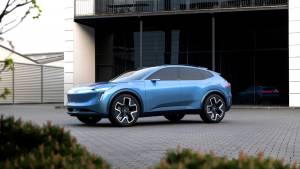An everyday electric car
Abhay Verma
Updated: May 09, 2013, 04:12 PM IST
The motor business in Europe and North America is groaning under the hype surrounding electric cars. As the Nissan Leaf and Chevrolet Volt go on sale, encouraged by state rebates and the promise of minimal running costs as well as ultra-low emissions, you might think that the era of the international combustion engine is over and that the electric revolution has begun.
The truth is that, although most of the major manufacturers will launch electric cars over the next couple of years, even their most optimistic proponents only expect
them to account for 10 per cent of all new cars sold. So there is still plenty of life in the piston engine.
The pure electric cars that are available â" or about to become so â" all have a problem with their batteries. The latest lithium-ion power batteries are more efficient at storing energy than the previous lead-acid, nickel-cadmium and nickel-metal hydride types but remain bulky, heavy and expensive.
More batteries give more range but weigh and cost more. Most manufacturers have settled for a nominal 160km range for a battery electric vehicle (BEV) as the best compromise in price and practicality.
Run out of charge and you are stranded. They call it 'range anxiety' and it is a real issue that restricts BEVs to short, predictable journeys, after which they can be re-charged, a process that takes between 30 minutes and eight hours depending on the equipment available.
So there is a simple, undeniable logic about the Chevrolet Volt, which is an EREV, extended range electric vehicle. Its maker, General Motors, which pursued the Volt's development through the upheaval of bankruptcy and government control, insists that it is an electric car. Others call it a serial hybrid, for it has a good old-fashioned petrol engine to drive a generator, and hence the car, when the batteries are depleted.
The Volt's battery-only range is 60km but with the combustion engine running, the 33-litre fuel tank can take it up to 500km â" and then be re-fuelled in a few minutes. Range anxiety overcome; perhaps this is the perfect solution.
Perhaps. The Volt has just gone on sale in the US but I have been driving a pre-production car in Europe, restyled as the Opel Ampera. (It will also be sold as the Chevrolet Volt in Europe and for the UK the Ampera becomes a Vauxhall.)
Like all electric cars, it moves off smoothly, quietly and briskly. Like the Leaf, it feels well planted on the road; the suspension and the chassis platform, is derived from the Opel Astra and Chevrolet Cruze and the weighty batteries are located low down at the centre of the car.
So there is nothing unusual to report in a typical low-speed journey, starting with the batteries fully charged after four hours plugged into the household mains. It gets more interesting when you ask for more speed and when the car's electronics judge that the batteries have reached their safe low limit (actually about 20 per cent of their capacity). Then the petrol engine starts unobtrusively and later you realise that there is a familiar background noise which rises and falls in response to the accelerator.

Because of concerns about patents, General Motors has only recently described the Volt's drivetrain and it is more complicated than we had been led to believe. There are two drive motors, one of which doubles as the generator and they are connected with the petrol engine through a planetary gear system. Electronically-controlled clutches engage one or both motors, the second accompanied by a reduction gear to give a higher overall ratio, and the petrol engine. When maximum performance is demanded, all three 'engines' can be operating together, and at that point there is a direct connection between the petrol engine and the wheels; hence, competitors' claims that the Volt is really a Prius-like hybrid.
During development, first thoughts were that the petrol engine â" a standard GM four-cylinder â" would run at constant speed but actually it has three operation maps, between 2,000 and 4,500rpm, to give optimum assistance.
Of course, all this happens automatically and the system is designed to feel familiar to the driver of a regular car, whether running using the batteries or with the petrol engine running. The controls are familiar, the transmission selector like a regular automatic: select 'D' and off you go.
Inside, the facia and instruments are futuristic. That's appropriate as they have to provide different information from conventional cars. There are two 'fuel' gauges â" one for the petrol tank and the other to show the percentage of battery charge. An illuminated 'bubble' at the centre of the display changes colour depending on whether you are accelerating (gold), coasting or driving gently (green) or braking (blue). In amongst it nestles a digital speedometer.
The LCD screen in the middle of the facia provides all kinds of information, with an emphasis on energy saving. As part of the Volt's development process, GM engineers focused on the energy consumption
of things we have always taken for granted â" wipers, lights, audio system, and, especially the air conditioning system. They chose not to provide energy regeneration from coasting, only from braking, but that was in the interests of maintaining a normal driving experience.
This car is about the same size as a Skoda Laura and accommodates four people in spacious comfort. A fifth seat in the back was not really practical because of the height of the battery pack which occupies the central tunnel. Its shape is distinctive in the way of the Toyota Prius and Honda Insight: short bonnet, arched window line, high tail. The only jarring feature is the way that black masking has been used on the doors as a continuous body line and to make the windows seem deeper than they actually are.
The snag with the range extender idea is that two engines are inevitably more expensive than one and there is a weight penalty. The Ampera's kerb weight is a hefty 1715kg, so its 0-100kmph acceleration time of around 9 seconds and 160kmph maximum speed are creditable. Obviously, its fuel consumption depends on usage and how often and for how long the petrol engine is running. After trying various equivalence formulae, the Europeans have decided that 1.6lit/100km and 40g/km CO2 is a reasonable average. That is low enough to count for the various rebates and incentives for purchasing a low-carbon car.
In the UK, the Ampera has already been priced: £34,000 (Rs 24.17 lakh approx) before rebates, £5,000 (Rs 3.56 lakh) more than the Nissan Leaf. But, unlike the Leaf, the Opel can be used as a primary vehicle and is capable of going anywhere. It would not be the choice for long distance trips but it wouldn't leave you stranded if you ventured outside the electric comfort zone.
General Motors is already thinking about the next stage of development. Initially, the Volt and the Ampera are being made in America at the Hamtramck plant in Detroit. The second generation will also be produced in Europe, perhaps at the UK factory at Ellesmere Port. By 2015, GM plans to have a trio of zero or ultra-low emissions cars in Europe: a battery electric city car (BEV), the range-extended Volt/Ampera (EREV) and the first hydrogen-fuelled FCEV â" fuel-cell electric vehicle.
Price (Ex-Delhi)
Starts Rs 13.95 Lakhs
Starts Rs 13.95 Lakhs
Displacement
1998cc
1998cc
Transmission
Manual
Manual
Max Power(ps)
166
166
Max Torque(Nm)
360
360
Mileage
17.3 Kmpl
17.3 Kmpl
Price (Ex-Delhi)
-NA-
-NA-
Displacement
-NA-
-NA-
Transmission
Automatic
Automatic
Max Power(ps)
149.5
149.5
Max Torque(Nm)
320
320
Mileage
-NA-
-NA-
Related Stories
Advertisement
Advertisement
Top Stories
Advertisement
Latest Videos
Most Popular
- Budget Sportbike Showdown: Kawasaki Ninja 500 vs Aprilia RS 457 vs Yamaha YZF-R3
- 2014 Triumph Daytona 675 vs 2024 Kawasaki ZX6R - A Decade of Evolution in Supersport Motorcycles
- Mumbai-Pune Expressway speed restrictions updated
- Nissan Magnite EZ-Shift review - is the AMT any good?
- Nitin Gadkari states that tax on Hybrids should be reduced to 12 percent in the coming future
Advertisement
1
2
1
2
Network18 Updates
Compare













